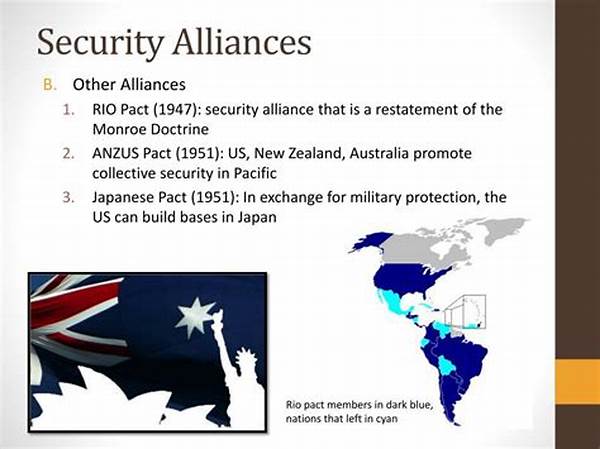Historical Context and Evolution
The development of defense alliances has been a pivotal aspect of international relations throughout history. Alliances have formed and evolved in response to both geopolitical threats and shared interests among nations. The historical context offers insight into why states pursue these partnerships, focusing on collective security and the deterrence of aggression. From the ancient alliances in the Greek city-states to modern defense pacts like NATO, the essence of these alliances remains the same: to create a unified front in defense of common goals and objectives.
In the post-World War II era, the development of defense alliances gained renewed importance as nations sought stability in a world recovering from conflict. The Cold War period particularly exemplified this trend, with Western countries rallying around NATO and the Soviet sphere consolidating power through the Warsaw Pact. These alliances were not just military arrangements; they also represented a confluence of political and ideological convictions.
Today, with emerging threats such as cyber warfare and terrorism, the development of defense alliances continues to adapt. Modern alliances increasingly focus on multi-dimensional security concerns, requiring flexible, cooperative strategies that transcend traditional military engagement. Hence, understanding the historical evolution of these alliances is crucial in assessing their current vitality and future relevance.
Key Factors Influencing Alliances
1. The development of defense alliances is often influenced by geopolitical interests and strategic military necessity, compelling nations to forge partnerships that enhance collective security.
2. Technological advancements play a significant role in the development of defense alliances, as countries collaborate to integrate cutting-edge technologies for superior defense capabilities.
3. Economic interdependence is a driving factor in the development of defense alliances, encouraging countries to secure stable environments for trade and investment through collective defense.
4. Political ideologies significantly impact the development of defense alliances, often aligning states with similar governance models and values to strengthen unity and cooperation.
5. Regional stability and peacekeeping missions are central to the development of defense alliances, as member states collaborate to mitigate conflicts and promote global peace.
The Role of International Organizations
The development of defense alliances is heavily influenced by international organizations that provide platforms for cooperation and dialogue. Entities such as the United Nations and regional organizations like the European Union or the African Union facilitate collaborative approaches to global security. These bodies offer mechanisms for conflict resolution, peacekeeping initiatives, and endorse collective defense measures that align with international law and norms.
Central to the development of defense alliances in this context is the adherence to broad international agreements that govern the use of force and the pursuit of security objectives. The involvement of international organizations ensures that alliances operate within a framework that promotes global stability and accountability. This multilayered approach underscores the interconnected nature of modern defense arrangements, underscoring the necessity for cooperation beyond bilateral agreements.
Challenges and Opportunities
The development of defense alliances faces numerous challenges, such as differing national interests, budget constraints, and political changes. However, these challenges also present opportunities for innovation and reform within alliances. Nations must navigate complex geopolitical landscapes by fostering flexibility and adaptability within their defense structures. The development of defense alliances offers countries the chance to address pressing security concerns collaboratively, leveraging shared resources and expertise.
Effective communication and trust-building measures are crucial in overcoming potential frictions within alliances. The development of defense alliances requires a commitment from member states to uphold shared objectives and maintain unity in response to external threats. Additionally, opportunities to expand alliances through partnerships with non-traditional state and non-state actors can enhance global security efforts, offering diversified approaches to international defense strategies.
Case Studies of Modern Alliances
Contemporary examples of the development of defense alliances can be observed in both traditional military domains and emerging security fields. Notably, the North Atlantic Treaty Organization (NATO) has expanded its role to include cybersecurity, illustrating the shift in alliance priorities to encompass broader security threats beyond conventional warfare.
Similarly, regional cooperative efforts such as the ASEAN Defense Ministers’ Meeting (ADMM) highlight the development of defense alliances focusing on Asia-Pacific security issues. These alliances emphasize the importance of regional peace and stability while addressing transnational challenges like maritime security and counter-terrorism efforts. These case studies exemplify the adaptability and relevance of alliances in addressing evolving security landscapes.
Future Prospects and Developments
As the global security environment continues to evolve, the development of defense alliances will play a crucial role in shaping future strategic landscapes. The rise of non-traditional security threats such as cyber threats, climate change, and pandemics necessitates a reevaluation of alliance structures and priorities. Nations must adapt their defense strategies to encompass these emerging challenges, thereby ensuring the ongoing relevance and effectiveness of alliances.
Furthermore, the expanding technological landscape offers new opportunities for collaboration within alliances. The development of defense alliances will increasingly integrate advanced technologies like artificial intelligence and autonomous systems, reshaping traditional military operations. Countries must work together to establish standards and protocols that ensure these advancements contribute to international stability rather than exacerbate tensions.
Summary and Conclusion
In summary, the development of defense alliances has consistently been a cornerstone of international security frameworks. Throughout history, such alliances have been instrumental in shaping geopolitical dynamics and are pivotal in the pursuit of collective security. Modern alliances reflect an increased complexity, as they now address multifaceted threats and incorporate diverse strategic objectives.
As the world progresses into an era characterized by rapid technological advancements and novel security threats, the development of defense alliances remains vital. By maintaining resilience and adaptability, these alliances can successfully navigate challenges and capitalize on opportunities presented by the evolving global security environment. Consequently, the significance of defense alliances extends beyond mere military considerations, influencing political, economic, and social dimensions on a global scale.





